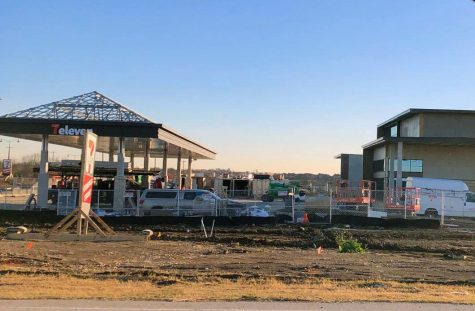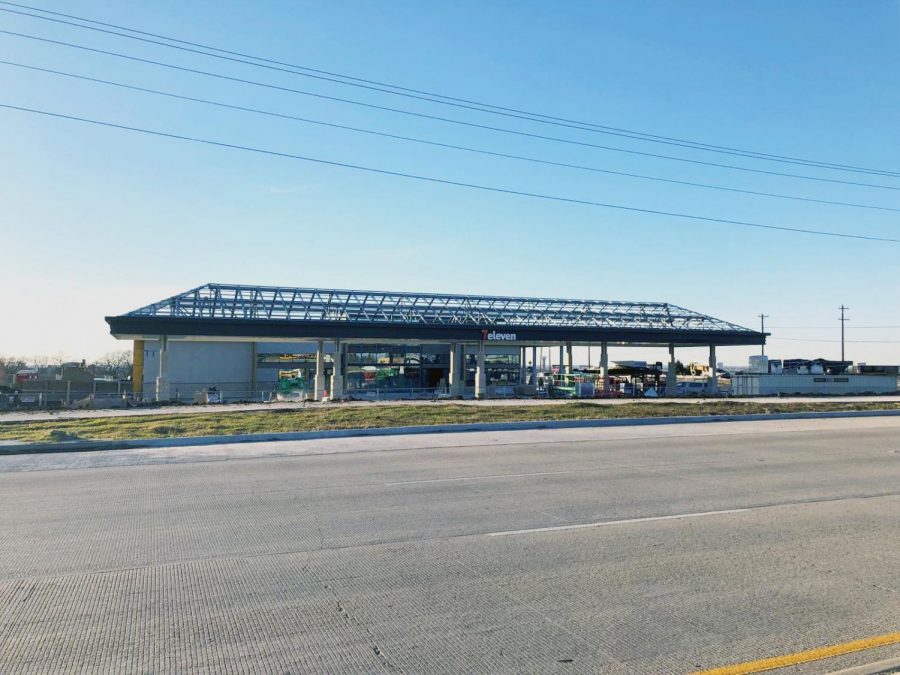Column: Gas station opening increases health risks for Prosper residents
Against a bright blue sky, the new 7-Eleven on West Frontier Pkwy is being built. The construction is just one of the ongoing projects seen all around Prosper. “Gas stations are very convenient when you’re in the middle of nowhere,” sophomore Gianna Galante said. “We need more of them in certain places because it’s kind of inconvenient not to have any.”
The new 7-Eleven gas station opening outside of Light Farms may do more harm than good, according to recent studies done by health and nutrition researchers. An increase in available convenience stores correlates with weight gain and obesity in children, according to the study published Dec. 10 in the “Journal of the Academy of Nutrition and Dietetics.” For example, having an additional convenience store within a mile of a child’s home over 24 months resulted in an 11.7% greater risk of a child being in a higher body mass index (BMI) range, an estimate of body fat based on weight and height, compared to other children of the same sex and age.

A study on neighborhood risk factors for obesity found that metropolitan area residents with a supermarket in their zip code were 11% less likely to be obese. The existence of supermarkets in an individual’s near location decreased the likelihood of being obese, while the presence of a convenience store had the opposite effect. A similar finding was reported in a study of adolescents where increased access to supermarkets lowered the average adolescent body mass index and overweight status, while convenience store access increased obesity rates.
Gas stations also release benzene and other compounds to the air, which increase the likelihood of nausea, low-birth weight, cancer, and other adverse health effects among those living, working, or learning within 500- to 1,000-feet. Fast food restaurants and convenience stores, such as well-known gas station franchises in the U.S., sell products dense in calories and high in sodium and sugar, which have played a large role in the epidemic of obesity, high blood pressure and diabetes. These restaurant-convenience stores are collectively known as “food swamps.”
Even taking out the health risks of the equation, gas prices alone have gone up from access to gas station foods. Americans are now pumping 938 million gallons of fuel more annually than they were in 1960, as a result of extra weight in vehicles. And when gasoline prices average $3 a gallon, the tab for overweight people in a vehicle amounts to $7.7 million daily, or $2.8 billion yearly. The numbers are added costs linked directly to the extra drain of body weight on the fuel economy. A scientific paper issued in the journal, “The Engineering Economist” concluded that each extra pound of body weight in all of today’s vehicles results in the need for more than 39 million gallons of extra gasoline usage each year.
For Prosper, these are health risks that shouldn’t be taken lightly. Known for its high-quality school district, we have a large population of elementary-age children. Our families should be careful and monitor their children’s access to gas station products. One ice cream cone may seem like a one-time occasion until it becomes a weekly tradition. Let’s help each other stay healthy.
Your donation will support the student journalists of Prosper High School. Your contribution will allow us to purchase equipment and cover our annual website hosting costs.

Honors, Experience and Awards:
5 Best of Sno publications.
5th place in Copy Editing, district UIL meet 2021
Honorable mention- Podcast interview, 2021 TAJE Fall Fiesta
UIL Journalist 2020-2021, 2021-2022
Quill and Scroll Society member 2021-2022
1st place in Copy Editing for CENTEX UIL meet 2021-2022
3rd place in Copy Editing for Aubrey UIL meet 2022
2nd place in Copy Editing for NorTex UIL District meet 2022
National Silver award for poetry from the Scholastic Art & Writing organization
National Recognition Award from College Board
AP Scholar with Distinction Award
2 Best in Texas News & Broadcast Awards, 2022: Personal Opinion Column- Honorable Mention, News Story- Honorable Mention
President of the Classic Book Club, 2020-onwards
Member of the National Spanish Honors Society (NSHS)
PHS Award for Academic Excellence in Newspaper II, 2022
Dean’s Scholarship for Cornell University Pre -College Program
Sibley Scholarship for Brown University Pre -College Program
CIEE Global Navigator Scholarship







![Freshman Polly Greaves created this updated version of the original graphic through Canva. Their next episode reviews a science fiction novel, 'Ender's Game.' "I feel like [Orson Scott Card] did a really good job incorporating feelings into his words and the plot," Greaves said, "which really made it a work of art because I believe that good books are books that can make you feel something."](https://eaglenationonline.com/wp-content/uploads/2025/02/EndersGame_Cover3-600x420.png)







Guadalupe D Guillory • Mar 19, 2021 at 11:39 pm
Also most neighborhoods have local donut shops.
Lisa Roskens • Mar 20, 2021 at 11:59 am
That’s true, too, Guadalupe!
Guadalupe D Guillory • Mar 19, 2021 at 8:20 am
I think the gas station will be a great stop for many people going to work. I’m looking forward to the tacos!
As far as it being a danger to Prosper it’s up to the parents what their kids consume and up to the parents what they themselves spend money on. This area continues to grow and that cant be stopped.
Kalyani Rao • Mar 19, 2021 at 8:50 am
Guadalupe, you definitely have a point! Thanks for reading our student newspaper.